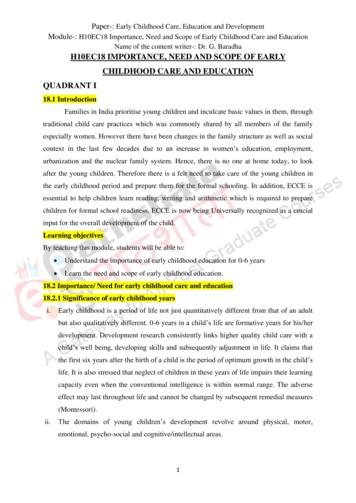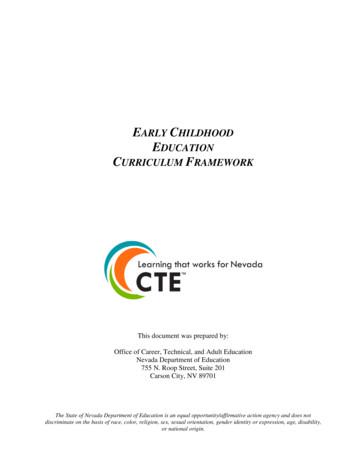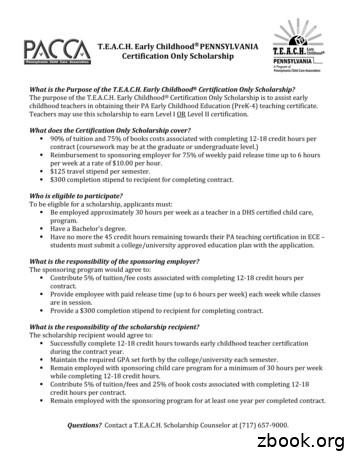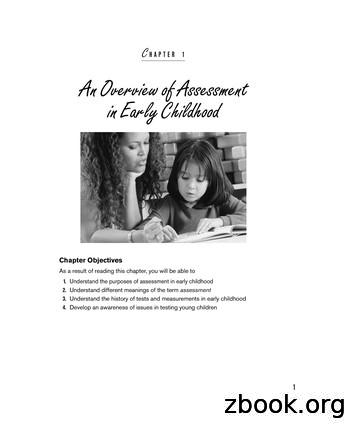Early Childhood Education In English For Speakers Of
Early Childhood Education inEnglish for Speakers ofOther LanguagesEdited by Victoria A Murphy and Maria Evangelou
Early Childhood Education inEnglish for Speakers ofOther LanguagesEdited by Victoria A Murphy and Maria EvangelouEarly Childhood Education.indb 111/01/2016 12:56
ISBN 978-0-86355-782-8 British Council 201610 Spring GardensLondon SW1A 2BN, UKwww.britishcouncil.orgEarly Childhood Education.indb 211/01/2016 12:56
ContentsForewordJohn Knagg, OBE. 3IntroductionVictoria A Murphy and Maria Evangelou.41Global Perspectives. 191.1 North AmericaRethinking early childhood education for English language learners:the role of languageFred Genesee.211.2 South AmericaEarly childhood bilingual education in South AmericaAnne-Marie de Mejía.431.3 EuropeEuropean perspectives on early childhood and care in English forspeakers of other languagesVictoria A Murphy, Maria Evangelou, Jenny Goff and Rebecca Tracz.571.4 I ndiaEarly childhood education in English in IndiaPadmini Shankar and Paul Gunashekar.751.5 AfricaBeyond ABC: the complexities of early childhood education in TanzaniaNipael Mrutu, Pauline Rea-Dickins,Fortidas Bakuza and Shelina Walli.911.6 AustraliaMaking the ESL classroom visible: indigenous Australianchildren’s early educationLauren Gawne, Gillian Wigglesworth and Gemma Morales.1111.7 E astern AsiaEnglish as a foreign language (EFL) and English medium instruction(EMI) for three- to seven-year-old children in East Asian contextsYanling Zhou and Mei Lee Ng. 137Contents Early Childhood Education.indb 1111/01/2016 12:56
2Case Studies in Immersion / EMI.1592.1 S upporting the home language of English as an additionallanguage (EAL) children with developmental disordersJohanne Paradis. 1612.2 A setting-based oral language intervention for nursery-agedchildren with English as an additional languageSilke Fricke and Gill Millard. 1712.3 L anguage of instruction and the development of biliteracyskills in children: a case study of a pre-school in the MaldivesNaashia Mohamed.1872.4 D o Hong Kong pre-school teachers of English engage in learningand teaching activities conducive to young children’s vocabularydevelopment?Richard Wong Kwok Shing.1952.5 A case study of early childhood education and the pre-schoolcurriclum in SingaporeLynn Ang.2072.6 N ursery rhymes for cognitive development: from listeningcomprehension to maths skillsKalyani Samantray. 2173Case studies in EFL contexts. 2313.1 Just singing, role playing and reading: a case study ineducation for bilingualismClaudia Lucía Ordóňez.2333.2 P re-school children’s production of sibilant phonemes in English:developing phonemic awareness through multi-sensory teachingAlberto Navarro Martinez, Yvette Coyle and Julio Roca de Larios. 2413.3 Facilitating the learning of English through collaborative practiceSandie Mourăo and Penelope Robinson.2533.4 A short, in-service training course for pre-school teachers in FranceGail Ellis.2653.5 R hythmic patterns in stories and word order production (adjective )in four-year-old EFL learnersSarah Hillyard.27924EpilogueVictoria A Murphy and Maria Evangelou. 2955Contributors. 303 ContentsEarly Childhood Education.indb 211/01/2016 12:56
ForewordThe British Council asked Victoria A. Murphy and Maria Evangelou to put togetherthis wide-ranging book on English language learning in the early stages ofeducation (pre-primary, or ages 0 to seven years) as a result of increased interestand incidence of practice in the area – perhaps the final frontier in the rush toteach and learn English at ever younger ages – combined with a relative lack ofspecific research and experience sharing.Quality early childhood education and care (ECEC) has become more and morewidespread globally in both state and private sectors over recent years anddecades, though there is still lamentably a huge discrepancy in access. Researchhas shown the added value to later achievements of quality education at this vitalpre-primary stage. Equally, there has been an ever-growing demand, especiallyfrom parents, to ensure that children leave school with a mastery of English, whichis seen as the international language of communication in more and more domains,and a key to social and economic improvement. This volume provides a variety ofperspectives on how these two social trends can come together to give children anadvantage in their multilingual development alongside physical, emotional, socialand cognitive development, in a way that is age appropriate and without the needfor a false divide between the world of work and play. The editors tell us that thereare no cognitive impediments or negative consequences to learning more than onelanguage in young children when done well, and the contributors show us thatdoing it well includes having well-prepared teachers, a well-designed curriculum,good resources, considered policies and supportive parents.A number of core values and beliefs underpin this volume. We believe in qualityearly childhood education for all. We believe in working tirelessly for increasedunderstanding across cultures, for valuing cultural diversity, and for promotingmultilingualism. That means that while we work to develop a wider knowledge ofEnglish across the world in response to clear demand, we will never forget theimportance of the mother tongue and local languages that mean that children cantalk to their grandparents and learn from them, and which carry with them theglorious array of cultures and ways of being that the human race embraces. As theeditors say, a world that only speaks English would be bleak indeed. We support anadditive bilingual education that supports the home language as well as the widerdevelopment of creative and wise global citizens who will look after our planet farinto the future.We hope that this volume will inspire practitioners and policy-makers, and form apart of the classes and reading lists for initial and in-service early childhoodteacher education courses. Our thanks go to the editors for their expertise andefforts in putting this innovative collection together, as well as to the manycontributors for sharing their experience and wisdom with us.John Knagg OBEBritish CouncilForeword Early Childhood Education.indb 3311/01/2016 12:56
IntroductionVictoria A Murphy, Maria Evangelou, University of Oxford“Viewed freely, the English language is the accretion and growth of every dialect,race and range of time, and is both the free and compacted composition of all.”Walt WhitmanThe story of the Tower of Babel is perhaps an interesting metaphor for theinternational power of the English language. In the tale, humans are reaching forthe heavens through the construction of their tower, achievable through theirability to communicate effectively with one another. God was not pleased with thisidea, and hence the solution was to confuse the language of the world such thatpeople began to speak many different languages, were no longer able tounderstand each other, and hence could no longer aim to reach heaven in theirearthly lives. This story suggests that if we can communicate effectively with eachother, the sky is the limit in terms of human achievement (indeed, in the story ofBabel, maybe the sky is not even the limit!). Is the English language the new Babel?The eagerness to learn English that we see around the world does rather suggestthat fuelling the desire to learn English is the belief that it will somehow betransformative for people’s lives, it being considered a cornerstone of futureeconomic and personal success. While English is the fourth most spoken languageby native speakers (after Mandarin, Hindi and Spanish), more people (i.e. totalnumber of speakers) speak English around the world than any other language(approximately one thousand five hundred million, c.f. www.statista.com). While it isnot obvious that the whole world speaking English means we will reach heaven, it isclear that sharing such a global lingua franca has direct and specific consequenceson numerous aspects of life, including education.A number of research studies have identified a growing international phenomenonwhere different forms of education are offered through the medium of English tonon-English speakers. One of the main underlying reasons for this expansion ofsuch forms of education undoubtedly lies (in part) in the success of the Frenchimmersion programmes established in Canada by Lambert and Tucker (1972). Inthis programme, primary school children are educated for part of the school day intheir native language (English) and in the other part of the day, in the secondlanguage (French). Many studies have since shown that immersion is a highlysuccessful form of bilingual education since it promotes higher levels of orallanguage proficiency in the second language (L2) and higher levels of L2 literacyskills than would be found in more traditional taught programmes (e.g. Genesee,1987, 2004; Murphy, 2014). As a result of the success of immersion education,immersion programmes have proliferated throughout the world (see Murphy, 2014for a review). It is likely, therefore, that due to the international success ofimmersion education in raising achievements in L2 or foreign language (FL)learning, English language education (and particularly English immersionprogrammes) has similarly escalated. In the sphere of higher education, forexample, Dearden (2015) reports on the rapid expansion of programmes offered4 IntroductionEarly Childhood Education.indb 411/01/2016 12:56
through English Medium Instruction (EMI) around the world. Interestingly, thegeneral support and feelings for EMI are equivocal – not everyone in Dearden’sresearch (who were British Council staff from 55 countries) felt that EMI wasself-evidently a good idea, while some viewed it as potentially controversial andreported feeling that EMI might have potentially negative consequences for lowersocio-economic groups or for first language maintenance and/or education. This isan idea we will return to later on.At the other end of the educational spectrum, Rixon (2013) shows that despiteresearch indicating that successful English language learning is not determined(only) by the age of the learner, many countries have reduced the age at whichEnglish as a Foreign Language (EFL) instruction is introduced into the primary, andoften the pre-primary, curriculum. She suggests that introducing EFL at young agescan be problematic when the materials, quality teacher education and generallyappropriate conditions for learning are not in place. This view is consistent withMurphy (2014) who also argued that it is not the age of the learner that is the mostpowerful predictor of EFL success but, rather, the context (i.e. nature of theprovision, materials, teachers, parental support, and the like). Rixon (2013) alsocomments that the proliferation of English language teaching is particularly notablein Early Childhood Education and Care (ECEC) settings despite the fact that herresearch showed that in many contexts resources are either lacking or notsufficient to the task.At the same time that English language learning is being offered in numerousdifferent educational programmes (from ECEC up to higher education), more andmore children are participating in ECEC. The Office for Economic Co-operation andDevelopment (OECD)’s family database shows that between the years 2003–10, allcountries in the OECD experienced significant increases in enrolment in formalchildcare and pre-school services for children under three years of age as well asincreases in enrolment rates of children aged three to five years (OECD, 2014).Additionally, many countries have very high proportions (sometimes close to 100per cent) of three-to-five-year-old children attending formal pre-school educationalprogrammes (OECD, 2014)1. Given that higher numbers of young children areparticipating in ECEC and, as Rixon (2013) showed, increasingly are being offeredEnglish through ECEC, it is timely to examine English language learning throughECEC with children who do not speak English.This volume brings these two issues – the proliferation of English languageeducation and increased participation in ECEC – together. It provides an overarching discussion of pertinent issues, research findings and concerns/challengesrelated to the education of children between 0 and seven years old through themedium of English (EMI) or through EFL instruction. The first section of this volumepresents critical discussion of key issues related to specific ‘global perspectives’where each continent is represented – except Antarctica, as it is virtuallyuninhabited. Contributions from North and South America, Europe, Africa, India,1Unfortunately, it is also true that many of the poorest children in the world are not able to access good quality ECEC(UNICEF, 2014)Introduction Early Childhood Education.indb 5511/01/2016 12:56
Australia and East Asia from researchers and/or language teaching and learningprofessionals working within these regions present detailed discussion of centraltopics specific to these contexts in relation to ECEC in English for non-Englishspeakers. The second section of this volume presents more local discussion ofparticular projects related to ECEC in English across the world. These ‘case studies’are sub-divided into those relevant to the EMI or EFL contexts and show us theconsiderable variability in how researchers, teachers and other languageprofessionals are working within this growing international area. These discussionsrange from the very quantitatively research-oriented (e.g. the control trial in Frickeand Millard), to more ethnographic and descriptive projects carried out in Englishlanguage classrooms (e.g. Ang). While the majority of these case studies areultimately concerned with the child and their learning of English, some of themfocus on the environment in which the child is learning (i.e. the classroom-basedenvironment in Mourão and Robinson) and/or how we can best support teachers(e.g. Ellis), parents and/or other language professionals (e.g. Paradis). One coulduse the term ‘eclectic’ to characterise the range of topics and approaches in thisvolume. We deliberately adopted this multifaceted approach in putting this volumetogether because we believe that it is important to illustrate the significantdiversity of research and areas of discussion and concern in relation to ECEC inEnglish internationally. This diversity is important because we believe the area ofECEC through English for non-English speakers is itself in its early years from aresearch point of view. We hope, therefore, that this volume will serve as a catalystfor much more discussion and research.Why are non-English-speaking children aged zero to sevenlearning English at pre-school?The chapters in this volume illustrate some of the different reasons underpinningwhy children aged zero to seven years are being cared for or educated in English inthe pre-school years. The United Nations Department of Economic and SocialAffairs (UNDESA) reported that in 1990 there were approximately 156 millionmigrants worldwide. In 2010, this number increased to 214 million (Castles, 2013).In 2013, UNDESA reported that the number of immigrants rose to 232 million. In2015, at the time of writing, there is an international refugee crisis. It is quite clear,therefore, that one major reason for why some young children are learning Englishthrough educational provision is that they and/or their families have emigratedfrom a non-English-speaking country to an English-speaking one, where themedium of instruction is English. This setting is relevant to the discussion inGenesee’s chapter where he examines issues concerning the education of EnglishLanguage Learners (ELLs) in North America, children whose home language is notEnglish but who, by virtue of living in North America, are being educated throughthe medium of English. Paradis’ chapter also is set within this context, where shediscusses the important, and often neglected, issue of children with developmentaldisorders who are growing up bilingually. She shatters the myth that developingbilingually is somehow detrimental to children with disorders that can affect theirlinguistic development. Fricke and Millard also present an interesting randomisedcontrol trial set within this context of ethnic minority children growing up inEngland. Many children with English as an Additional Language (EAL) come to6 IntroductionEarly Childhood Education.indb 611/01/2016 12:56
school with under-developed oral language skills (relative to native-speakingchildren) (Dockrell et al., 2010) and Fricke and Millard discuss the results of asuccessful oral language intervention aimed at helping pre-school children withEAL develop their vocabulary, and other oral language abilities. Murphy, Evangelouet al. (this volume) also include a discussion of children from ethnic minoritybackgrounds who are being educated through the medium of English. They discussresearch, which identifies some of the challenges for very young non-Englishspeaking children as they begin ECEC in English. One of these challenges is that theparents of children from ethnic minorities in English-speaking countries mightthemselves not speak very much English, which can then mean that the parents areless equipped to offer support for their children’s educational activities, an issuenoted in Genesee’s chapter. Starting school
children with English as an additional language Silke Fricke and Gill Millard . 3.3 Facilitating the learning of English through collaborative practice Sandie Mourăo and Penelope Robinson . 253 3.4 A short, in-service training course for pre-school teachers in France Gail Ellis . 265 3.5 Rhythmic patterns in stories and word order production (adjective ) in four-year-old EFL .
Understand the importance of early childhood education for 0-6 years Learn the need and scope of early childhood education. 18.2 Importance/ Need for early childhood care and education 18.2.1 Significance of early childhood years i. Early childhood is a period of life not just quantitatively different from that of an adult
Early Childhood Education I L1 Early Childhood Education II L2 Early Childhood Education III L3C Early Childhood Education Advanced Studies AS The core course sequencing with the complementary courses provided in the following table serves as a guide to schools for their programs of study.
ECE 240 - Administration of Early Childhood Care and Education Programs (3) ECE 241 - Administration: Human Relations for Early Childhood Education (3) Colorado Mesa University B.A. Early Childhood Education - Early Childhood Special Education Advisor: Vail Shoultz-McCole vshoultz@coloradomesa.edu 970-255-2674
Early Childhood Care, Development and Education (ECCDE) is a term that is used interchangeably worldwide but refers to the same concept of early childhood education and cognitive development. The World Bank for instance refers to it as Early Childhood Care and Education, whereas UNESCO refers to it as Early Childhood Development Care.
T.E.A.C.H. Early Childhoodâ PENNSYLVANIA Certification Only Scholarship What is the Purpose of the T.E.A.C.H. Early Childhood Certification Only Scholarship? The purpose of the T.E.A.C.H. Early Childhood Certification Only Scholarship is to assist early childhood teachers in obtaining their PA Early Childhood Education (PreK-4) teaching certificate.
Center-Based and Family Child Care Early Childhood Education Reviewer The Early Childhood Education (ECE) Reviewer must meet one of the following sets of education and experience options: Education and Experience Option I 1. B.A., B.S., or advanced degree in early childhood education/child development or home
CHAPTER 1 An Overview of Assessment in Early Childhood Understanding Assessment in Infancy and Early Childhood Not too long ago, resources on early childhood assessment were limited to occa-sional articles in journals, chapters in textbooks on teaching in early childhood pro-grams, and a few small textbooks that were used as secondary texts in .
diploma in early childhood development & education If you have a natural love for children and a strong interest in early childhood education, then why not play an active role in shaping a child's growth with our Diploma in Early Childhood Development & Education [ECDE]?























